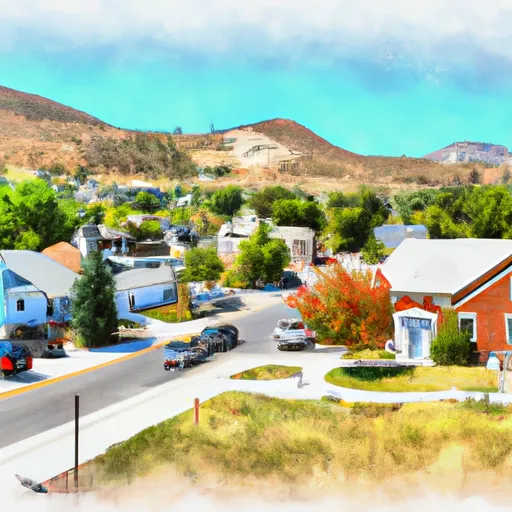-
 Snoflo Premium
Snoflo Premium
Get unlimited access to all our content
With no Ad interruptions! - Start Your Free Trial Login with existing account
Mantua
Eden Index
Climate
8.8
•
Recreation
3.9
•
Community
•
Safeguard
4.9/10

Mantua, Utah is a charming town located in Box Elder County, nestled in the northern part of the state. The climate in Mantua is characterized by four distinct seasons. Summers are generally warm with temperatures ranging from the mid-70s to low 90s Fahrenheit, making it an ideal time for outdoor activities. Winters, on the other hand, are cold and snowy, with temperatures dropping below freezing.
Hydrology constituents in Mantua are primarily centered around Mantua Reservoir, a popular recreational spot. The reservoir is fed by several streams and springs, providing a reliable water source for outdoor enthusiasts. Fishing is a popular activity, with anglers catching trout, bass, and perch. Boating, kayaking, and paddleboarding are also enjoyed on the reservoir during the warmer months.
Mantua boasts several outdoor recreation opportunities, with Mantua Peak Trail being a highlight. This scenic trail offers hikers breathtaking views of the surrounding mountains and valleys. Additionally, the area provides ample opportunities for camping, picnicking, and wildlife viewing. Mantua is a perfect destination for nature lovers seeking a peaceful and adventurous escape.
What is the Eden Index?
The Snoflo Eden Index serves as a comprehensive rating system for regions, evaluating their desirability through a holistic assessment of climate health, outdoor recreation opportunities, and natural disaster risk, acknowledging the profound impact of these factors on livability and well-being.
Climate Health Indicator (CHI): 8.8
Mantua receives approximately
788mm of rain per year,
with humidity levels near 63%
and air temperatures averaging around
8°C.
Mantua has a plant hardyness factor of
6, meaning
plants and agriculture in this region thrive during a short period during spring and early summer. Most
plants will die off during the colder winter months.
By considering the ideal temperature range, reliable water supplies, clean air, and stable seasonal rain or snowpacks, the Climate Health Indicator (CHI) underscores the significance of a healthy climate as the foundation for quality living.
A healthy climate is paramount for ensuring a high quality of life and livability in a region, fostering both physical well-being and environmental harmony. This can be characterized by ideal temperatures, reliable access to water supplies, clean air, and consistent seasonal rain or snowpacks.
Weather Forecast
Streamflow Conditions
Lower Bear
Area Rivers
Lower Bear
Snowpack Depths
Lower Bear
Reservoir Storage Capacity
Lower Bear
Groundwater Levels
Recreational Opportunity Index (ROI): 3.9
The Recreational Opportunity Index (ROI) recognizes the value of outdoor recreational options, such as parks, hiking trails, camping sites, and fishing spots, while acknowledging that climate plays a pivotal role in ensuring the comfort and consistency of these experiences.
Access to outdoor recreational opportunities, encompassing activities such as parks, hiking, camping, and fishing, is crucial for overall well-being, and the climate plays a pivotal role in enabling and enhancing these experiences, ensuring that individuals can engage in nature-based activities comfortably and consistently.
Camping Areas
| Campground | Campsites | Reservations | Toilets | Showers | Elevation |
|---|---|---|---|---|---|
| Dry Canyon | 3 | 6,314 ft | |||
| High Creek | 2 | 5,521 ft | |||
| Smithfield | 6 | 5,566 ft |
Nearby Ski Areas
Catastrophe Safeguard Index (CSI):
The Catastrophe Safeguard Index (CSI) recognizes that natural disaster risk, encompassing floods, fires, hurricanes, and tornadoes, can drastically affect safety and the overall appeal of an area.
The level of natural disaster risk in a region significantly affects safety and the overall livability, with climate change amplifying these risks by potentially increasing the frequency and intensity of events like floods, fires, hurricanes, and tornadoes, thereby posing substantial challenges to community resilience and well-being.
Community Resilience Indicator (CRI):
The Community Resilience Indicator (CRI) recognizes that education, healthcare, and socioeconomics are crucial to the well-being of a region. The CRI acknowledges the profound impact of these elements on residents' overall quality of life. By evaluating educational resources, healthcare accessibility, and economic inclusivity, the index captures the essential aspects that contribute to a thriving community, fostering resident satisfaction, equity, and social cohesion.

